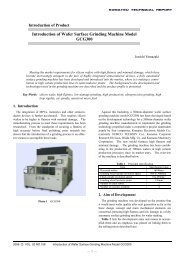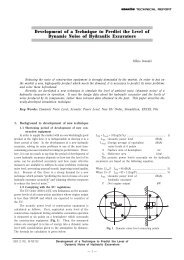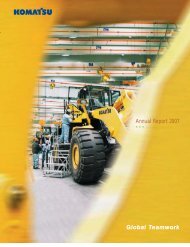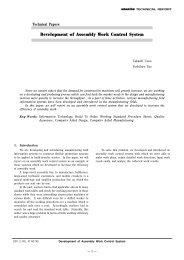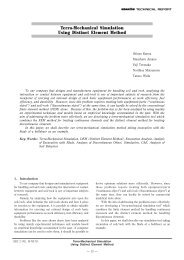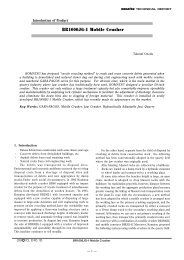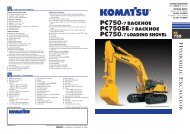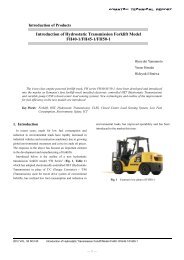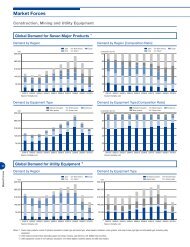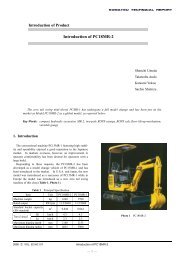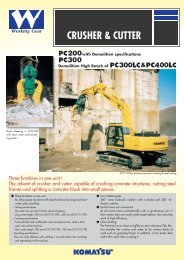Introduction of HD465-7/605-7 Dump Trucks in GALEO ... - Komatsu
Introduction of HD465-7/605-7 Dump Trucks in GALEO ... - Komatsu
Introduction of HD465-7/605-7 Dump Trucks in GALEO ... - Komatsu
You also want an ePaper? Increase the reach of your titles
YUMPU automatically turns print PDFs into web optimized ePapers that Google loves.
2003 q VOL. 49 NO.151<br />
<strong>Introduction</strong> <strong>of</strong> <strong>HD465</strong>-7/<strong>605</strong>-7<br />
<strong>Dump</strong> <strong>Trucks</strong> <strong>in</strong> <strong>GALEO</strong> Series<br />
<strong>Introduction</strong> <strong>of</strong> <strong>HD465</strong>-7/<strong>605</strong>-7<br />
<strong>Dump</strong> <strong>Trucks</strong> <strong>in</strong> <strong>GALEO</strong> Series<br />
— 38 —<br />
Setsuo K<strong>in</strong>oshita<br />
The DX Series that was put on sale <strong>in</strong> 1989 was completely remodeled for the first time <strong>in</strong> 13 years.<br />
As the first <strong>GALEO</strong> Series <strong>of</strong> rigid dump trucks, we have <strong>in</strong>troduced Models <strong>HD465</strong>-7 and HD<strong>605</strong>-7 to the<br />
market.<br />
These new models <strong>in</strong>corporate many <strong>of</strong> <strong>Komatsu</strong>’s most advanced technologies to meet the customer<br />
needs that were identified by <strong>in</strong>-depth surveys <strong>of</strong> the relevant markets. This paper describes the salient<br />
features <strong>of</strong> the new models.<br />
Key Words: Rigid <strong>Dump</strong> <strong>Trucks</strong>, Response to Tier 2 Emissions Regulations, Enhancement <strong>of</strong> Safety,<br />
Reduction <strong>of</strong> R/M Cost, Gearshift Interlock Control, ARSC/ASR/VHMS.<br />
1. <strong>Introduction</strong><br />
S<strong>in</strong>ce <strong>in</strong>troduction, the DX Series <strong>of</strong> dump trucks had been<br />
popular among many users because <strong>of</strong> high work efficiency,<br />
good rid<strong>in</strong>g quality, etc. However, more than 10 years had<br />
passed s<strong>in</strong>ce the last remodel<strong>in</strong>g and hence, a thoroughgo<strong>in</strong>g<br />
review <strong>of</strong> the DX Series that had no rivals for years was be<strong>in</strong>g<br />
called <strong>in</strong> the face <strong>of</strong> the change <strong>in</strong> user needs, the <strong>in</strong>troduction<br />
<strong>of</strong> new models by competition, etc.<br />
Photo 1 Model <strong>HD465</strong>-7<br />
On the other hand, as exemplified by the enforcement <strong>of</strong><br />
str<strong>in</strong>gent emissions regulations and the mount<strong>in</strong>g cry for<br />
control <strong>of</strong> noise <strong>in</strong> recent years, grow<strong>in</strong>g attention is be<strong>in</strong>g paid<br />
to protection <strong>of</strong> the environment and respect for humanity.<br />
It was, therefore, necessary to positively review the DX Series.<br />
Under those conditions, <strong>Komatsu</strong> developed and <strong>in</strong>troduced<br />
to the market Model <strong>HD465</strong>-7 and HD<strong>605</strong>-7 dump trucks which<br />
are safe and friendly to the environment and which <strong>in</strong>corporate<br />
many advanced technologies (Photo 1).
2. Objective <strong>of</strong> development<br />
In launch<strong>in</strong>g development <strong>of</strong> Model <strong>HD465</strong>-7/<strong>605</strong>-7 dump<br />
trucks, <strong>Komatsu</strong> carried out an extensive market survey <strong>in</strong><br />
Europe, North America, and Southeast Asia which are the most<br />
promis<strong>in</strong>g markets for <strong>Komatsu</strong>’s dump trucks. The survey<br />
results showed that many users were strongly call<strong>in</strong>g for a higher<br />
degree <strong>of</strong> safety and a higher cost performance ratio. Therefore,<br />
we decided to develop Model <strong>HD465</strong>-7/<strong>605</strong>-7 dump trucks – the<br />
first <strong>GALEO</strong> Series <strong>of</strong> products – with ‘safe, pr<strong>of</strong>itable dump<br />
trucks’ as the watchword (Table 1).<br />
Table 1 Objectives <strong>of</strong> development<br />
Sell<strong>in</strong>g po<strong>in</strong>t (development concept)<br />
Item<br />
Content<br />
Positive response to<br />
environmental protection/ • Meet<strong>in</strong>g Tier 2 Emissions Regulations<br />
regulations<br />
High work efficiency • Improv<strong>in</strong>g acceleration/hill climb<strong>in</strong>g<br />
performance by <strong>in</strong>creas<strong>in</strong>g eng<strong>in</strong>e torque<br />
• Secur<strong>in</strong>g outstand<strong>in</strong>g maneuverability<br />
High cost performance ratio • Reduc<strong>in</strong>g cost <strong>of</strong> periodical ma<strong>in</strong>tenance<br />
Outstand<strong>in</strong>g safety<br />
Cab amenity<br />
2003 q VOL. 49 NO.151<br />
• Reduc<strong>in</strong>g cost <strong>of</strong> overhaul<br />
• Facilitat<strong>in</strong>g management <strong>of</strong> mach<strong>in</strong>es<br />
• Facilitat<strong>in</strong>g chang<strong>in</strong>g tires<br />
• Facilitat<strong>in</strong>g mach<strong>in</strong>e transportation (<strong>in</strong> Japan)<br />
• Improv<strong>in</strong>g brake reliability and durability<br />
• Improv<strong>in</strong>g brak<strong>in</strong>g performance markedly<br />
• Improv<strong>in</strong>g rid<strong>in</strong>g quality and reduc<strong>in</strong>g<br />
transmission shock<br />
• Quiet cab <strong>in</strong>terior<br />
• Reduc<strong>in</strong>g shock made by low<strong>in</strong>g <strong>of</strong> dump body<br />
3. Sell<strong>in</strong>g po<strong>in</strong>ts and means <strong>of</strong> atta<strong>in</strong><strong>in</strong>g them<br />
The means <strong>of</strong> atta<strong>in</strong><strong>in</strong>g the objectives set for the first<br />
models <strong>of</strong> the <strong>GALEO</strong> Series rigid dump trucks shall be<br />
expla<strong>in</strong>ed below <strong>in</strong> the order <strong>in</strong> which they are listed <strong>in</strong> Table 1.<br />
3.1 Positive response to environmental protection /<br />
regulations<br />
(1) Clean, powerful SAA6D170E-3 eng<strong>in</strong>e<br />
q Equipped with an electronically-controlled, high-pressure<br />
fuel <strong>in</strong>jection (HPI) system, an air-cooled aftercooler, a<br />
high-efficiency turbocharger, etc., the SAA6D170E-3 eng<strong>in</strong>e<br />
boasts outstand<strong>in</strong>g fuel efficiency and exceptionally low<br />
levels <strong>of</strong> exhaust emissions while secur<strong>in</strong>g a very large<br />
output per mach<strong>in</strong>e weight as compared with other eng<strong>in</strong>es<br />
<strong>of</strong> the same class.<br />
w The eng<strong>in</strong>e has met the Tier 2 Emissions Regulations <strong>of</strong><br />
the M<strong>in</strong>istry <strong>of</strong> Land, Infrastructure and Transport (Japan),<br />
<strong>of</strong> the EPA, and <strong>of</strong> the EU (Photo 2).<br />
Photo 2 SAA6D170E-3 eng<strong>in</strong>e<br />
<strong>Introduction</strong> <strong>of</strong> <strong>HD465</strong>-7/<strong>605</strong>-7<br />
<strong>Dump</strong> <strong>Trucks</strong> <strong>in</strong> <strong>GALEO</strong> Series<br />
— 39 —<br />
3.2 High work efficiency<br />
(1) Compared with the former models which had a reputation<br />
for their work efficiency, the new models which are<br />
equipped with an SAA6D170E-3 eng<strong>in</strong>e have been given a<br />
higher torque rise (24% vs. 14%). As a result, their<br />
acceleration and hill-climb<strong>in</strong>g speed have <strong>in</strong>creased. This<br />
<strong>in</strong> turn has appreciably raised the work efficiency at hilly<br />
construction sites (Fig. 1).<br />
Uphill<br />
Level ground<br />
Downhill<br />
Model course<br />
10% gradient<br />
100m<br />
100m<br />
1800m<br />
Roll<strong>in</strong>g resistance: 2%<br />
2000m<br />
Roll<strong>in</strong>g resistance: 2%<br />
10% gradient<br />
1800m<br />
100m<br />
100m<br />
Roll<strong>in</strong>g resistance: 2%<br />
Speed limit<br />
Empty Loaded<br />
40<br />
km/h 30<br />
km/h<br />
40<br />
km/h 40<br />
km/h<br />
40<br />
km/h 30<br />
km/h<br />
300<br />
100<br />
0<br />
300<br />
200<br />
100<br />
0<br />
300<br />
200<br />
100<br />
0<br />
Work efficiency [ton/h]<br />
100 101<br />
<strong>HD465</strong>-5<br />
100<br />
<strong>HD465</strong>-5<br />
<strong>HD465</strong>-5<br />
<strong>HD465</strong>-7<br />
100<br />
<strong>HD465</strong>-7<br />
100 101<br />
Fig. 1 Comparison <strong>of</strong> work efficiency<br />
<strong>HD465</strong>-7<br />
3.3 High economical efficiency<br />
As compared with the former models, the overall cost <strong>of</strong><br />
repair and ma<strong>in</strong>tenance has been reduced by about 30% through<br />
extended time <strong>in</strong>terval <strong>of</strong> overhaul, reduced periodical ma<strong>in</strong>tenance<br />
cost, facilitated mach<strong>in</strong>e management, etc.<br />
(1) Reduced periodical ma<strong>in</strong>tenance cost<br />
The cost <strong>of</strong> periodical ma<strong>in</strong>tenance has been reduced by<br />
the follow<strong>in</strong>g measures.<br />
q Modify<strong>in</strong>g the hydraulic circuit to reduce the amount <strong>of</strong><br />
oil required<br />
w Extend<strong>in</strong>g the time <strong>in</strong>tervals <strong>of</strong> oil dra<strong>in</strong> and lubrication<br />
and reduc<strong>in</strong>g the number <strong>of</strong> oil filters<br />
e Employ<strong>in</strong>g a fully hydraulic brake control system<br />
t Mak<strong>in</strong>g the park<strong>in</strong>g brake free <strong>of</strong> ma<strong>in</strong>tenance<br />
(2) Reduced overhaul cost<br />
The cost <strong>of</strong> overhaul has been reduced not only by<br />
extend<strong>in</strong>g the time <strong>in</strong>tervals <strong>of</strong> overhaul <strong>of</strong> the ma<strong>in</strong> components<br />
but also by mak<strong>in</strong>g the disassembly/reassembly <strong>of</strong> components<br />
easier through the use <strong>of</strong> a split-type rear axle, etc.<br />
(3) Facilitated mach<strong>in</strong>e management<br />
The new models are equipped with a vehicle health<br />
monitor<strong>in</strong>g system (VHMS) as standard. This system, which
is effective for preventive ma<strong>in</strong>tenance, facilitates failure<br />
diagnosis and mach<strong>in</strong>e management. The VHMS controller<br />
performs a centralized, real-time control <strong>of</strong> the <strong>in</strong>dividual<br />
controllers which control the ma<strong>in</strong> components <strong>of</strong> the vehicle.<br />
By download<strong>in</strong>g data collected from the <strong>in</strong>dividual controllers<br />
to a personal computer and analyz<strong>in</strong>g the data on a cont<strong>in</strong>ual<br />
basis, it is possible to implement preventive ma<strong>in</strong>tenance <strong>of</strong><br />
the vehicle.<br />
In addition, the satellite communication capability (option)<br />
permits obta<strong>in</strong><strong>in</strong>g vehicle <strong>in</strong>formation on a real-time basis<br />
through the Web CARE.<br />
S<strong>in</strong>ce this system also <strong>of</strong>fers as an option the conventional<br />
payload meter (PLM) function, it is possible to analyze and<br />
control the vehicle operat<strong>in</strong>g condition even without the PLM<br />
controller (Fig. 2).<br />
2003 q VOL. 49 NO.151<br />
Payload meter function is <strong>in</strong>cluded <strong>in</strong> VHMS controller.<br />
PC tool<br />
(For data download)<br />
Input from sensors<br />
Exhaust temperature<br />
Eng<strong>in</strong>e oil temp.<br />
Eng<strong>in</strong>e blow-by pressure<br />
Eng<strong>in</strong>e RPM<br />
Eng<strong>in</strong>e Oil Pressure<br />
Coolant temperature<br />
Ambient temp.<br />
T/M fill signal<br />
T/C oil temp.<br />
Acc. pressure<br />
Retarder cool<strong>in</strong>g oil temp.<br />
RS232C<br />
Retarder controller<br />
(LE controller)<br />
Orbcomm controller<br />
S-NET<br />
(4) Facilitated tire replacement<br />
The rim fitt<strong>in</strong>g method has been changed (from wedge r<strong>in</strong>g<br />
fitt<strong>in</strong>g to flange fitt<strong>in</strong>g) to facilitate the tire replacement work<br />
(Fig. 3).<br />
<strong>HD465</strong>/<strong>605</strong>-7 <strong>HD465</strong>/<strong>605</strong>-5<br />
Fig. 3 Rim fitt<strong>in</strong>g method<br />
RS232C<br />
T/M Controller<br />
(LE controller)<br />
<strong>Introduction</strong> <strong>of</strong> <strong>HD465</strong>-7/<strong>605</strong>-7<br />
<strong>Dump</strong> <strong>Trucks</strong> <strong>in</strong> <strong>GALEO</strong> Series<br />
— 40 —<br />
External device<br />
VHMS controller<br />
with PLM function<br />
RS232C<br />
Eng<strong>in</strong>e Controller<br />
(CM500)<br />
Fig. 2 Scheme <strong>of</strong> VHMS configuration<br />
External display lamp<br />
Input from PLM Sensors<br />
*Sus.Pressure<br />
*Angle<br />
CAN<br />
Display<br />
function switch 1 2<br />
Monitor panel<br />
Display<br />
(5) Facilitated vehicle transportation<br />
A model <strong>of</strong> CS (civil eng<strong>in</strong>eer<strong>in</strong>g work’s special)<br />
specification for safe, easy split transportation has been made<br />
available to meet the request from many subcontractors that<br />
<strong>of</strong>ten transport their vehicles from one construction site to<br />
another.<br />
3.4 Outstand<strong>in</strong>g safety<br />
Compared with the former models, the new models have<br />
been markedly improved <strong>in</strong> safety by enhanc<strong>in</strong>g the reliability<br />
and durability <strong>of</strong> their components, ma<strong>in</strong>ly those <strong>of</strong> the brake<br />
system which is one <strong>of</strong> the most important parts to ensure<br />
safe operation, and adopt<strong>in</strong>g a high-rigidity cab to better protect<br />
the operator.
(1) Improved brake reliability and durability<br />
q Adoption <strong>of</strong> a fully hydraulic brake control<br />
A fully hydraulic brake control has been adopted to reduce<br />
the time lag <strong>in</strong> and improve the response <strong>of</strong> brak<strong>in</strong>g. In<br />
addition, the pneumatic devices have been abolished to improve<br />
the system reliability dramatically.<br />
Each <strong>of</strong> the front, rear, and park<strong>in</strong>g brakes consists <strong>of</strong><br />
an <strong>in</strong>dependent circuit provided with an accumulator. The<br />
park<strong>in</strong>g brake is a spr<strong>in</strong>g-applied, large-capacity, enclosed<br />
multi-disc type whose design assures a very high degree <strong>of</strong><br />
safety. The emergency brake control that is used if any <strong>of</strong><br />
the brake circuits fails has been changed from the lever type<br />
to a pedal type so as to improve the ease and speed <strong>of</strong> control<br />
operation (Fig. 4 and Fig. 9).<br />
2003 q VOL. 49 NO.151<br />
ACCUMULATOR<br />
(PARKING)<br />
PUMP<br />
ACCUMULATOR<br />
(FRONT)<br />
EMERGENCY<br />
BRAKE PEDAL<br />
ACCUMULATOR<br />
(REAR)<br />
RELAY VALVE<br />
BRAKE VALVE<br />
(2-pressure control)<br />
180kg/cm 2<br />
100kg/cm 2<br />
RETARDER VALVE<br />
Electromagnetic proportional<br />
reduc<strong>in</strong>g valve<br />
w Adoption <strong>of</strong> a built-<strong>in</strong> park<strong>in</strong>g brake<br />
As mentioned <strong>in</strong> the preced<strong>in</strong>g paragraph, the park<strong>in</strong>g brake<br />
has been built <strong>in</strong> the rear axle to make it free <strong>of</strong> ma<strong>in</strong>tenance<br />
and improve its reliability significantly (Fig. 5).<br />
REAR BRAKE SLACK ADJUSTER<br />
Fig. 4 Fully hydraulic brake control circuits (<strong>HD465</strong>-7)<br />
<strong>Introduction</strong> <strong>of</strong> <strong>HD465</strong>-7/<strong>605</strong>-7<br />
<strong>Dump</strong> <strong>Trucks</strong> <strong>in</strong> <strong>GALEO</strong> Series<br />
— 41 —<br />
PARKING BRAKE VALVE<br />
SWITCH<br />
PARKING BRAKE<br />
When service<br />
brake is applied<br />
FRONT BRAKE<br />
FRONT BRAKE CUT VALVE<br />
When park<strong>in</strong>g<br />
brake is released<br />
Fig. 5 Structures <strong>of</strong> rear and park<strong>in</strong>g brakes (<strong>HD465</strong>-7)
(2) Improved brake operation<br />
q Adoption <strong>of</strong> ARSC as standard<br />
The automatic retard speed control (ARSC) is similar <strong>in</strong><br />
function to the automatic cruise control <strong>of</strong> a passenger car.<br />
When the vehicle is runn<strong>in</strong>g downhill, the ARSC automatically<br />
keeps the vehicle at a preset speed. Thus, the ARSC permits<br />
the operator to drive the vehicle down the hill at a constant<br />
speed without manipulat<strong>in</strong>g the speed retarder by hand (Fig. 6<br />
and Fig. 7).<br />
The ma<strong>in</strong> functions <strong>of</strong> the ARSC are shown below.<br />
(a) The vehicle descend<strong>in</strong>g speed can be set at the touch<br />
<strong>of</strong> a lever (sett<strong>in</strong>g range: 10 to 55 km/h).<br />
2003 q VOL. 49 NO.151<br />
Increas<strong>in</strong>g speed<br />
Decreas<strong>in</strong>g speed<br />
UP<br />
CANCEL<br />
DOWN<br />
<strong>Introduction</strong> <strong>of</strong> <strong>HD465</strong>-7/<strong>605</strong>-7<br />
<strong>Dump</strong> <strong>Trucks</strong> <strong>in</strong> <strong>GALEO</strong> Series<br />
— 42 —<br />
(b) The set vehicle speed can be adjusted <strong>in</strong> <strong>in</strong>crements/<br />
decrements <strong>of</strong> 1 km/h (up to ± 5 km/h) with the lever.<br />
(c) When the retarder is anticipated to become overheated,<br />
the vehicle speed is automatically slowed down. If a<br />
retarder overheat occurs, an audible caution is issued.<br />
w ABS/ASR (options)<br />
(a) ABS (anti-lock brak<strong>in</strong>g system)<br />
The ABS prevents tires from gett<strong>in</strong>g locked when the brakes<br />
are applied. This system detects the tire rotation <strong>of</strong> each <strong>of</strong> the<br />
four wheels <strong>in</strong>dependently, and when there are any tires which<br />
are likely to get locked, it automatically controls the brak<strong>in</strong>g<br />
torque and thereby ma<strong>in</strong>ta<strong>in</strong>s stable vehicle position and steer<strong>in</strong>g.<br />
SET<br />
Fig. 6 ARSC manipulator and display<br />
The ARSC detects the tire rotational speed (vehicle speed) and acceleration, and fuzzy-controls<br />
the retarder hydraulic pressure (brak<strong>in</strong>g force).<br />
Thanks to fuzzy control, the ARSC is capable <strong>of</strong> controll<strong>in</strong>g the retarder hydraulic pressure while<br />
predict<strong>in</strong>g the vehicle behavior.<br />
If the tires are locked, the ARSC releases the hydraulic pressure to unlock them.<br />
Unlike the CAT eng<strong>in</strong>e speed control, the ARSC controls the vehicle at a constant speed and<br />
hence, the recovery is fast.<br />
Tire rotational speed is<br />
converted <strong>in</strong> terms<br />
<strong>of</strong> vehicle speed.<br />
Controller command<br />
Retarder hydraulic<br />
pressure<br />
Acceleration<br />
<strong>of</strong>f<br />
If travel<strong>in</strong>g speed is<br />
higher than preset speed<br />
Retarder force is<br />
controlled accord<strong>in</strong>g<br />
to fuzzy control map.<br />
Acceleration<br />
<strong>of</strong>f<br />
If travel<strong>in</strong>g speed is<br />
lower than preset speed<br />
Retarder force is<br />
controlled accord<strong>in</strong>g<br />
to fuzzy control map.<br />
Fig. 7 Outl<strong>in</strong>e <strong>of</strong> ARSC operation<br />
Display <strong>of</strong> set vehicle speed<br />
Increase<br />
<strong>in</strong> speed<br />
Brak<strong>in</strong>g force Fuzzy control map<br />
Vehicle speed<br />
– Large<br />
+ Small + Large<br />
Tire lock detected<br />
Retarder hydraulic<br />
pressure released<br />
If tire lock occurs<br />
– Small<br />
Time
(b) ASR (automatic sp<strong>in</strong> regulator)<br />
When either <strong>of</strong> the driv<strong>in</strong>g wheels slips on a s<strong>of</strong>t ground,<br />
etc., the ASR automatically applies the brake to the slipp<strong>in</strong>g<br />
wheel and transmits the driv<strong>in</strong>g force to the other wheel. This<br />
is effective to ma<strong>in</strong>ta<strong>in</strong> stable run <strong>of</strong> the vehicle and prevent<br />
the vehicle from gett<strong>in</strong>g stuck <strong>in</strong> the mud (Fig. 8).<br />
e Motor-operated retarder lever and emergency brake pedal<br />
A motor-operated retarder lever was adopted and the<br />
emergency brake control was changed from the conventional<br />
lever-operated type to a foot-operated (pedal) type to improve<br />
the ease <strong>of</strong> brak<strong>in</strong>g work (Fig. 9).<br />
3.5 Improved operator comfort<br />
All the dump trucks <strong>of</strong> <strong>Komatsu</strong> have long had a reputation<br />
for their comfortable cabs. The new models are provided with a<br />
wide, noise-<strong>in</strong>sulated cab with built-<strong>in</strong> ROPS/FOPS. In addition,<br />
the new functions “eng<strong>in</strong>e-transmission <strong>in</strong>terlock control” and “skip<br />
shift” that are performed dur<strong>in</strong>g transmission have been added<br />
to improve the rid<strong>in</strong>g quality. Furthermore, an electronic hoist<br />
control has been adopted to significantly reduce the shock that is<br />
applied to the vehicle body dur<strong>in</strong>g soil discharg<strong>in</strong>g work.<br />
(1) Improvement <strong>of</strong> rid<strong>in</strong>g quality and reduction <strong>of</strong> transmission<br />
shock<br />
q Eng<strong>in</strong>e-transmission <strong>in</strong>terlock control<br />
The “eng<strong>in</strong>e-transmission <strong>in</strong>terlock control” function has<br />
been newly added to the electronic full-range modulation<br />
system K-ATOMiCS whose performance has been proved by<br />
the former models. This new function synchronizes the eng<strong>in</strong>e<br />
and transmission speeds dur<strong>in</strong>g transmission to allow for<br />
smoother transmission and reduce the peak torque and thereby<br />
prolong the life <strong>of</strong> the power tra<strong>in</strong> (Fig. 10).<br />
2003 q VOL. 49 NO.151<br />
<strong>Introduction</strong> <strong>of</strong> <strong>HD465</strong>-7/<strong>605</strong>-7<br />
<strong>Dump</strong> <strong>Trucks</strong> <strong>in</strong> <strong>GALEO</strong> Series<br />
— 43 —<br />
When vehicle is runn<strong>in</strong>g<br />
on ord<strong>in</strong>ary ground<br />
Item <strong>HD465</strong>-5 <strong>HD465</strong>-7<br />
Evaluation/<br />
aim<br />
Rotation <strong>of</strong><br />
parts<br />
Clutch hydraulic pressure<br />
Lock-up<br />
clutch<br />
Speed<br />
clutch<br />
Fuel <strong>in</strong>jection<br />
rate<br />
• S<strong>in</strong>ce the eng<strong>in</strong>e speed <strong>in</strong>creases dur<strong>in</strong>g shift-up, the<br />
change <strong>in</strong> speed when the clutch is thrown <strong>in</strong> <strong>in</strong>creases.<br />
As the amount <strong>of</strong> energy <strong>of</strong> <strong>in</strong>ertia produced becomes large,<br />
a shock <strong>of</strong> acceleration occurs.<br />
F1 F2<br />
100%<br />
Shift-up signal<br />
E/G rotation<br />
T/M <strong>in</strong>put rotation<br />
T/C runn<strong>in</strong>g for some<br />
time after clutch<br />
engagement<br />
If this tire slips The brake is applied to the tire<br />
If either <strong>of</strong> the driv<strong>in</strong>g wheels beg<strong>in</strong>s to slip while the<br />
vehicle is runn<strong>in</strong>g over a s<strong>of</strong>t ground, the ASR<br />
automatically applies the brake to the slipp<strong>in</strong>g wheel to<br />
reduce the amount <strong>of</strong> slippage and at the same time,<br />
transmits the driv<strong>in</strong>g force to the other wheel. This<br />
improves the drivability <strong>of</strong> the vehicle.<br />
Fig. 8 Explanation <strong>of</strong> ASR operation<br />
Fig. 9 Arrangement <strong>of</strong> brake pedal and levers<br />
• Help with synchronization <strong>of</strong> eng<strong>in</strong>e/transmission speeds<br />
by regulat<strong>in</strong>g the fuel <strong>in</strong>jection rate dur<strong>in</strong>g shift-up.<br />
• Improve the shift-up feel<strong>in</strong>g by reduc<strong>in</strong>g the shift-up time.<br />
• Secure good acceleration and improve L/C shock by<br />
adopt<strong>in</strong>g a half L/C.<br />
Fuel <strong>in</strong>jection is stopped to restra<strong>in</strong><br />
the rise <strong>of</strong> eng<strong>in</strong>e speed.<br />
Lock-up immediately after<br />
clutch engagement<br />
Good acceleration secured<br />
Half lock-up<br />
Clutch <strong>of</strong>f Clutch on Clutch <strong>of</strong>f<br />
Clutch on<br />
Clutch engagement is detected from<br />
relative difference <strong>in</strong> rotational speed<br />
and the gradient <strong>of</strong> hydraulic pressure<br />
is caused to rise suddenly.<br />
Decided based on relative difference <strong>in</strong> rotational speed<br />
Fig. 10 Eng<strong>in</strong>e-transmission <strong>in</strong>terlock control (example <strong>of</strong> control dur<strong>in</strong>g shift-up)<br />
Fuel <strong>in</strong>jection<br />
control
w Skip shift<br />
This function shifts down the eng<strong>in</strong>e speed directly to the<br />
optimum speed stage accord<strong>in</strong>g to the load applied dur<strong>in</strong>g hillclimb<strong>in</strong>g<br />
<strong>in</strong> order to reduce the frequency <strong>of</strong> shift work, improve<br />
the rid<strong>in</strong>g quality, and prevent excavated soil from spill<strong>in</strong>g from<br />
the vehicle (Fig. 11).<br />
New model<br />
At the time <strong>of</strong> a shift-down while the throttle valve is fully opened,<br />
the target speed stage is changed accord<strong>in</strong>g to the speed<br />
reduction rate (deceleration rate) and the current speed stage is<br />
ma<strong>in</strong>ta<strong>in</strong>ed till the vehicle speed drops to a level at which the skip<br />
shift can be done. It should be noted, however, that even while<br />
the current speed stage is ma<strong>in</strong>ta<strong>in</strong>ed for the skip<br />
shift, if the deceleration rate varies due to a change<br />
<strong>in</strong> gradient <strong>of</strong> the slope, etc. and the skip shift is<br />
judged unsuitable, the vehicle speed is changed<br />
Former model<br />
F4<br />
Changed step by step<br />
F4<br />
2003 q VOL. 49 NO.151<br />
Shift down<br />
F4aF3<br />
Shift hold<br />
F4<br />
Shift down<br />
F3aF2<br />
Fig. 11 Image <strong>of</strong> skip shift function<br />
Shift down<br />
F4aF1<br />
Shift down<br />
F2aF1<br />
e Viscous cab mount<br />
The cab mount is a viscous mount employ<strong>in</strong>g rubber and<br />
silicone oil. This new mount reduces the mechanical vibration<br />
and noise com<strong>in</strong>g from the vehicle body and mitigates the<br />
operator fatigue, thereby <strong>in</strong>creas<strong>in</strong>g the work efficiency (Fig. 12).<br />
Fig. 12 Viscous mount<br />
(2) Noise-pro<strong>of</strong> cab <strong>in</strong>terior<br />
A high-rigidity cab with built-<strong>in</strong> ROPS/FOPS has been<br />
mounted on the vehicle body via the viscous mounts described<br />
<strong>in</strong> the preced<strong>in</strong>g paragraph. As a result, the cab <strong>of</strong>fers the<br />
operator a quieter and more comfortable space as it cuts <strong>of</strong>f<br />
much <strong>of</strong> the vibration and noise from the vehicle body.<br />
The follow<strong>in</strong>g improvements have been made on the<br />
conventional cab to reduce the level <strong>of</strong> noise arriv<strong>in</strong>g at the<br />
operator’s ears by 4 dB (A) (Fig. 13 and Photo 3).<br />
(a) Increas<strong>in</strong>g the overall cab rigidity by built-<strong>in</strong> ROPS<br />
(b) Improv<strong>in</strong>g the sound-<strong>in</strong>sulat<strong>in</strong>g performance by <strong>in</strong>creas<strong>in</strong>g<br />
the thicknesses <strong>of</strong> the floor plate and w<strong>in</strong>dow glass<br />
(c) Improv<strong>in</strong>g the hermetic seal <strong>of</strong> the cab<br />
(d) Add<strong>in</strong>g damp<strong>in</strong>g materials<br />
<strong>Introduction</strong> <strong>of</strong> <strong>HD465</strong>-7/<strong>605</strong>-7<br />
<strong>Dump</strong> <strong>Trucks</strong> <strong>in</strong> <strong>GALEO</strong> Series<br />
— 44 —<br />
Fig. 13 ROPS<br />
Photo 3 Cab <strong>in</strong>terior<br />
(3) Reduced body seat<strong>in</strong>g shock<br />
A newly-employed electronic hoist control has reduced the<br />
force required for hoist operation. In addition, the “body seat<strong>in</strong>g<br />
speed control” function has appreciably reduced the body seat<strong>in</strong>g<br />
shock dur<strong>in</strong>g discharge <strong>of</strong> excavated soil (Photo 4 and Fig. 14).<br />
Changeover valve<br />
BODY<br />
Hoist valve<br />
Photo 4 Hoist control lever<br />
Body position<br />
sensor<br />
PUMP EPC valve<br />
(electromagnetic proportional valve)<br />
Retarder<br />
controller<br />
<strong>Dump</strong> control<br />
(with potentiometer)<br />
Electric detent<br />
ALTERNATOR’ R’<br />
E/G SPEED<br />
Network<br />
<strong>in</strong>formation<br />
BODY SEATING<br />
LEVER’ FLOAT’<br />
LEVER’ RAISE’<br />
T/M controller<br />
Fig. 14 Electronic hoist control system configuration
4. Conclusion<br />
As the first ones <strong>of</strong> the <strong>GALEO</strong> Series <strong>of</strong> rigid dump<br />
trucks, Models <strong>HD465</strong>-7 and HD<strong>605</strong>-7 were developed to meet<br />
the Tier 2 Emissions Regulations.<br />
Due <strong>in</strong> part to a delay <strong>in</strong> start-up, the development<br />
schedule was tight. Nevertheless, the new models were put<br />
<strong>in</strong>to mass production almost as scheduled.<br />
Fortunately, the two models have been very well received<br />
by many customers s<strong>in</strong>ce they were put on the market. In<br />
addition, they are <strong>in</strong>creas<strong>in</strong>g their share <strong>in</strong> the dump truck<br />
market remarkably. These two facts are considered to attest<br />
to the validity <strong>of</strong> the development concept.<br />
2003 q VOL. 49 NO.151<br />
<strong>Introduction</strong> <strong>of</strong> <strong>HD465</strong>-7/<strong>605</strong>-7<br />
<strong>Dump</strong> <strong>Trucks</strong> <strong>in</strong> <strong>GALEO</strong> Series<br />
— 45 —<br />
<strong>Introduction</strong> <strong>of</strong> the writer<br />
Setsuo K<strong>in</strong>oshita<br />
Entered <strong>Komatsu</strong> <strong>in</strong> 1971. Currently<br />
work<strong>in</strong>g <strong>in</strong> Construction Equipment<br />
Technical Center 2, Development Division,<br />
<strong>Komatsu</strong>.<br />
[A few words from the writer]<br />
In the present development project, much time and difficulty was<br />
<strong>in</strong>volved <strong>in</strong> the <strong>in</strong>itial process up to the preparation <strong>of</strong> a practical<br />
project proposal. After that, I feel that the project was carried out<br />
speedily and smoothly.<br />
In order to complete the development by the time <strong>of</strong> enforcement<br />
<strong>of</strong> the Tier 2 Emissions Regulations, we worked hard to make up<br />
for lost time <strong>in</strong> the process <strong>of</strong> development.<br />
The development <strong>of</strong> the <strong>GALEO</strong> Series <strong>of</strong> rigid dump trucks is<br />
cont<strong>in</strong>ued <strong>in</strong> the years ahead. We <strong>in</strong>tend to make the most effective<br />
use <strong>of</strong> our experience <strong>in</strong> the development <strong>of</strong> the first two models<br />
and come up with new vehicles which are loved by as many<br />
customers as possible.



